Quantification of Moisture in Masonry via AI-Evaluated Broadband Radar Reflectometry
Abstract
1. Introduction
2. Measurements with Electromagnetic Radiation
2.1. Basic Principle
2.2. Approach
3. Materials and Methods
3.1. Materials
- Sander sandstone (SST), a regionally occurring building stone, which has already been quarried for a thousand years;
- Solid brick material (SBM) of company Wienerberger, corresponding in its material properties widely to a historic brick;
- Trass-lime mortar (TLM) Mur956 of company Maxit, a cement-free mortar that is also well-suited for masonry with natural stone.
3.2. Single Stones and Masonry Specimens
3.3. Methods
3.3.1. Hygrothermal Simulations
3.3.2. Single Stones
3.3.3. Masonry Specimen
3.3.4. Area Scans
3.3.5. Historic Buildings
- Nuremberg state archive constructed in 1880;
- Nuremberg primary school St. Johannis constructed in 1882;
- Historical house in Hohenpoelz (Franconian Switzerland) constructed sometime between 1880–1890.
3.4. Radar Measurements
3.4.1. Processing of Radar Data
3.4.2. Machine Learning Model (Neural Network)
- No/low salt load
- Medium salt load
- High salt load
4. Results
4.1. Single Stone Studies
4.2. Measurements Combined with Darr Method on Masonries
4.3. Area Scans of Masonries
4.4. On-Site Measurements of Historic Buildings
5. Discussion and Conclusions
Author Contributions
Funding
Data Availability Statement
Acknowledgments
Conflicts of Interest
References
- Franzen, C.; Mirwald, P.W. Moisture content of natural stone: Static and dynamic equilibrium with atmospheric humidity. Environ. Geol. 2004, 46, 391–401. [Google Scholar] [CrossRef]
- Hall, C.; Hoff, W.D. Water Transport in Brick, Stone and Concrete; CRC Press: Boka Raton, FL, USA, 2021. [Google Scholar]
- Steiger, M.; Charola, A.E.; Sterflinger, K. Weathering and deterioration. In Stone in Architecture: Properties, Durability; The Metropolitan Museum of Art: New York, NY, USA, 2011; pp. 227–316. [Google Scholar]
- Franzen, C.; Zötzl, M.; Trommler, U.; Hoyer, C.; Holzer, F.; Höhlig, B.; Roland, U. Microwave and radio wave supported drying as new options in flood mitigation of imbued decorated historic masonry. J. Cult. Herit. 2016, 21, 751–758. [Google Scholar] [CrossRef]
- Adamowski, J.; Hoła, J.; Matkowski, Z. Probleme und Lösungen beim Feuchtigkeitsschutz des Mauerwerks von Baudenkmälern am Beispiel zweier großer Barockbauten in Wrocław. Bautechnik 2005, 82, 426–433. [Google Scholar] [CrossRef]
- Zhou, X.; Derome, D.; Carmeliet, J. Analysis of moisture risk in internally insulated masonry walls. Build. Environ. 2022, 212, 108734. [Google Scholar] [CrossRef]
- Noor-E-Khuda, S.; Albermani, F. Flexural strength of weathered granites under wetting-drying cycles: Implications to steel structures. Adv. Steel Constr. 2019, 15, 225–231. [Google Scholar]
- Franzoni, E.; Sassoni, E. Correlation between microstructural characteristics and weight loss of natural stones exposed to simulated acid rain. Sci. Total Environ. 2011, 412–413, 278–285. [Google Scholar] [CrossRef]
- Gentilini, C.; Franzoni, E.; Bandini, S.; Nobile, L. Effect of salt crystallisation on the shear behaviour of masonry walls: An experimental study. Constr. Build. Mater. 2012, 37, 181–189. [Google Scholar] [CrossRef]
- Tomor, A.K.; Nichols, J.M.; Orbán, Z. Evaluation of the Loss of Uniaxial Compressive Strength of Sandstones Due to Moisture. Int. J. Arch. Herit. 2023. [Google Scholar] [CrossRef]
- Delgado, J.M.P.Q.; Guimarães, A.S.; de Freitas, V.P.; Antepara, I.; Kočí, V.; Černý, R. Salt Damage and Rising Damp Treatment in Building Structures. Adv. Mater. Sci. Eng. 2016, 2016, 1280894. [Google Scholar] [CrossRef]
- DIN EN 16682:2017-05; Conservation of Cultural Heritage—Methods of Measurement of Moisture Content, or Water Content, in Materials Constituting Immovable Cultural Heritage. Deutsches Institut für Normung: Berlin, Germany, 2017.
- WTA (2002): Messung der Feuchte von Mineralischen Baustoffen. WTA Merkblatt 4-11. Referat 4 Bauwerksabdichtung. Unter Mitarbeit von Uwe Schürger und Heinrich Wigger; Ausgabe: 12.2002/D, Endgültige Fassung: Oktober 2003. Fraunhofer IRB-Verlag; WTA Publications (WTA-Merkblatt, 4–11): Stuttgart, Pfaffenhofen.
- Flatt, R.J.; Caruso, F.; Sanchez, A.M.A.; Scherer, G.W. Chemo-mechanics of salt damage in stone. Nat. Commun. 2014, 5, 4823. [Google Scholar] [CrossRef]
- Scherer, G.W. Crystallization in pores. Cem. Concr. Res. 1999, 29, 1347–1358. [Google Scholar] [CrossRef]
- GANN. “Gann Hydromette Uni 1 + Uni 2”. 2001. Available online: https://www.gann.de/_Resources/Persistent/f108529c9e130dc739403b303170bb20b7d54d88/UNI1_UNI2_EN.pdf (accessed on 4 May 2023).
- Hoła, A. Measuring of the moisture content in brick walls of historical buildings—The overview of methods. IOP Conf. Ser. Mater. Sci. Eng. 2017, 251, 012067. [Google Scholar] [CrossRef]
- Gärnter, G.; Plagge, R.; Sonntag, H. Determination of moisture content of the outer wall using hf-sensor technology. In Proceedings of the 1st European Conference on Moisture Measurement, Weimar, Germany, 5–7 October 2010. [Google Scholar]
- Bayer, K.; Köhler, W.; Schuh, H.; Wendler, E. Vergleichsuntersuchungen mit unterschiedlichen zerstörungsfreien und zerstörungsarmen Feuchte- und Salzmessmethoden. In Konservierungswissenschaftliches Kolloquium in Berlin und Brandenburg; Hsg, S., Ed.; Lukas Verlag: Berlin, Germany, 2010; pp. 69–74. [Google Scholar]
- Hasted, J.B.; Shah, M.A. Microwave absorption by water in building materials. Br. J. Appl. Phys. 1964, 15, 825–836. [Google Scholar] [CrossRef]
- Pisa, S.; Pittella, E.; Piuzzi, E.D.; Atanasio, P.; Zambotti, A. Permittivity measurement on construction materials through free space method. In Proceedings of the I²MTC 2017 IEEE International Instrumentation and Measurement Technology Conference, Torino, Italy, 22–25 May 2017; IEEE: Piscataway, NJ, USA, 2017; pp. 1–4. [Google Scholar]
- Leschnik, W. Feuchtemessung an Baustoffen–Zwischen Klassik und Moderne. DGZfP-Berichtsband BB 69-CD. Ph.D. Thesis, Technische Universität Hamburg, Hamburg, Germany, 1999. [Google Scholar]
- Maierhofer, C.; Wöstmann, J. Investigation of dielectric properties of brick materials as a function of moisture and salt content using a microwave impulse technique at very high frequencies. NDT E Int. 1998, 31, 259–263. [Google Scholar] [CrossRef]
- Maierhofer, C.; Wöstmann, J.; Trela, C.; Röllig, M. Investigation of moisture content and distribution with radar and active thermography. In Proceedings of the RILEM Symposium on On Site Assessment of Concrete, Masonry and Timber Structures-SACoMaTiS 2008, Varenna, Italy, 1–2 September 2008; RILEM Pub: Bagneux, France, 2008; pp. 411–420. [Google Scholar]
- Dérobert, X.; Villain, G. Effect of water and chloride contents and carbonation on the electromagnetic characterization of concretes on the GPR frequency band through designs of experiment. NDT E Int. 2017, 92, 187–198. [Google Scholar] [CrossRef]
- Du Plooy, R.L.; Villain, G.; Lopes, S.P.; Ihamouten, A.; Dérobert, X.; Thauvin, B. Electromagnetic non-destructive evaluation techniques for the monitoring of water and chloride ingress into concrete: A comparative study. Mater. Struct. 2015, 48, 369–386. [Google Scholar] [CrossRef]
- Hugenschmidt, J.; Loser, R. Detection of chlorides and moisture in concrete structures with ground penetrating radar. Mater. Struct. 2008, 41, 785–792. [Google Scholar] [CrossRef]
- Kalogeropoulos, A.; Van Der Kruk, J.; Hugenschmidt, J.; Busch, S.; Merz, K. Chlorides and moisture assessment in concrete by GPR full waveform inversion. Near Surf. Geophys. 2011, 9, 277–286. [Google Scholar] [CrossRef]
- Ihamouten, A.; Villain, G.; Dérobert, X. Complex Permittivity Frequency Variations From Multioffset GPR Data: Hydraulic Concrete Characterization. IEEE Trans. Instrum. Meas. 2012, 61, 1636–1648. [Google Scholar] [CrossRef]
- Senin, S.; Hamid, R. Ground penetrating radar wave attenuation models for estimation of moisture and chloride content in concrete slab. Constr. Build. Mater. 2016, 106, 659–669. [Google Scholar] [CrossRef]
- Wutke, M.K. Use of Ground Penetrating Radar measurement combined to resistivity measurement for characterization of the concrete moisture. In Proceedings of the 17th International Conference on Ground Penetrating Radar (GPR). 2018 17th International Conference on Ground Penetrating Radar (GPR), Rapperswil, Switzerland, 18–21 June 2018; IEEE: Piscataway, NJ, USA, 2018; pp. 1–7. [Google Scholar]
- Lai, W.W.-L.; Kind, T.; Kruschwitz, S.; Wöstmann, J.; Wiggenhauser, H. Spectral absorption of spatial and temporal ground penetrating radar signals by water in construction materials. NDT E Int. 2014, 67, 55–63. [Google Scholar] [CrossRef]
- Binda, L.; Colla, C.; Forde, M. Identification of moisture capillarity in masonry using digital impulse radar. Constr. Build. Mater. 1994, 8, 101–107. [Google Scholar] [CrossRef]
- Binda, L.; Cardani, G.; Zanzi, L. Nondestructive Testing Evaluation of Drying Process in Flooded Full-Scale Masonry Walls. J. Perform. Constr. Facil. 2010, 24, 473–483. [Google Scholar] [CrossRef]
- Agliata, R.; Bogaard, T.A.; Greco, R.; Mollo, L.; Slob, E.C.; Steele-Dunne, S.C. Non-invasive estimation of moisture content in tuff bricks by GPR. Constr. Build. Mater. 2018, 160, 698–706. [Google Scholar] [CrossRef]
- Orr, S.A.; Fusade, L.; Young, M.; Stelfox, D.; Leslie, A.; Curran, J.; Viles, H. Moisture monitoring of stone masonry: A comparison of microwave and radar on a granite wall and a sandstone tower. J. Cult. Herit. 2020, 41, 61–73. [Google Scholar] [CrossRef]
- Delphin (6.1.5) [Software]. 2023 Bauklimatik Dresden. Available online: https://www.bauklimatik-dresden.de/delphin/index.php (accessed on 5 April 2023).
- Wissenschaftlich-Technische Arbeitsgemeinschaft für Bauwerkserhaltung und Denkmalpflege (2019): Salzreduzierung an Porösen Mineralischen Baustoffen Mittels Kompressen; Deutsche Fassung vom Dezember 2019, Ausgabe 12/2019/D; Fraunhofer IRB-Verlag, (WTA-Merkblatt, 3-13): Stuttgart, Germany, 2019.
- Proceq GP8800|Ground Penetrating Radar. 2023. Available online: https://www.screeningeagle.com/en/products/proceq-gp8800-ultraportable-concrete-gpr-radar (accessed on 2 March 2023).
- Sachse, W.; Pao, Y.-H. On the determination of phase and group velocities of dispersive waves in solids. J. Appl. Phys. 1978, 49, 4320–4327. [Google Scholar] [CrossRef]
- Singer, F. Mess- und Analysemethoden in der Laserakustik bei breitbandiger Laseranregung. Tech. Mess. 2015, 82, 45–51. [Google Scholar] [CrossRef]
- Blaschke, O.; Brand, F.; Drese, K.S. Quantification of Humidity and Salt Detection in Historical Building Materials via Broadband Radar Measurement. Sensors 2023, 23, 4616. [Google Scholar] [CrossRef]
- Franzen, C.; Siedler, G.; Franzen, C.; Vetter, S. Orthogonal IRT imaging. In Proceedings of the 2013 Digital Heritage International Congress (DigitalHeritage), Marseille, France, 8 October–1 November 2013; pp. 633–636. [Google Scholar] [CrossRef]
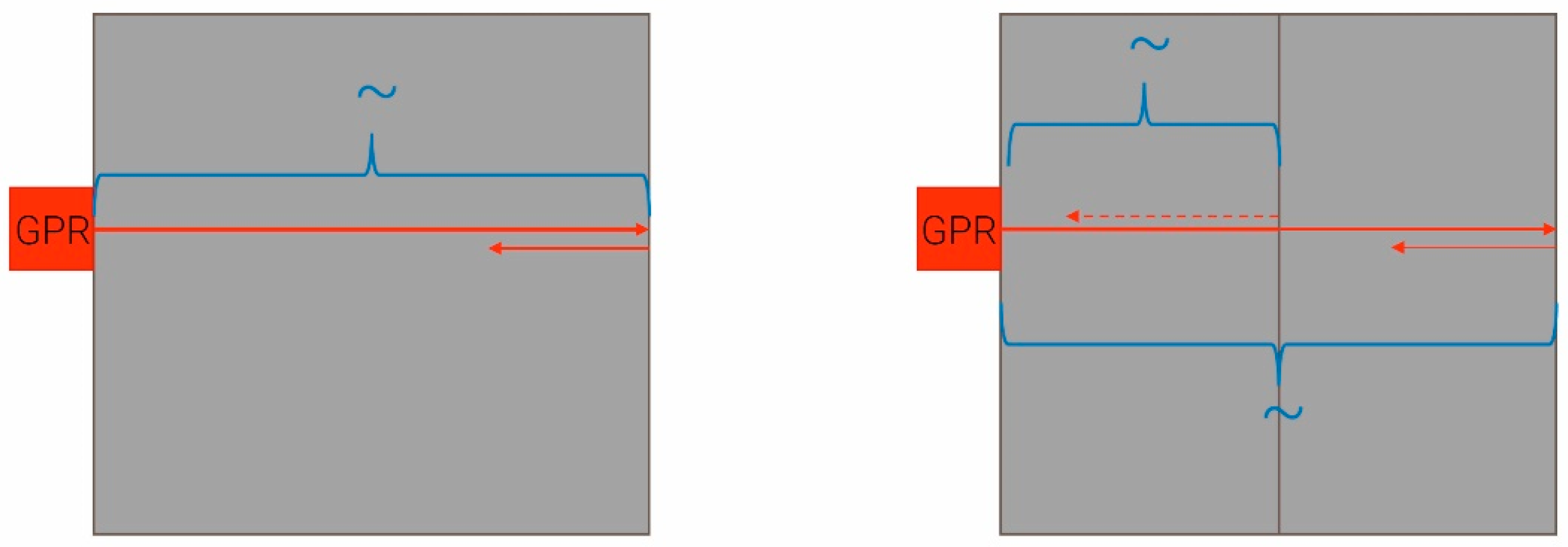
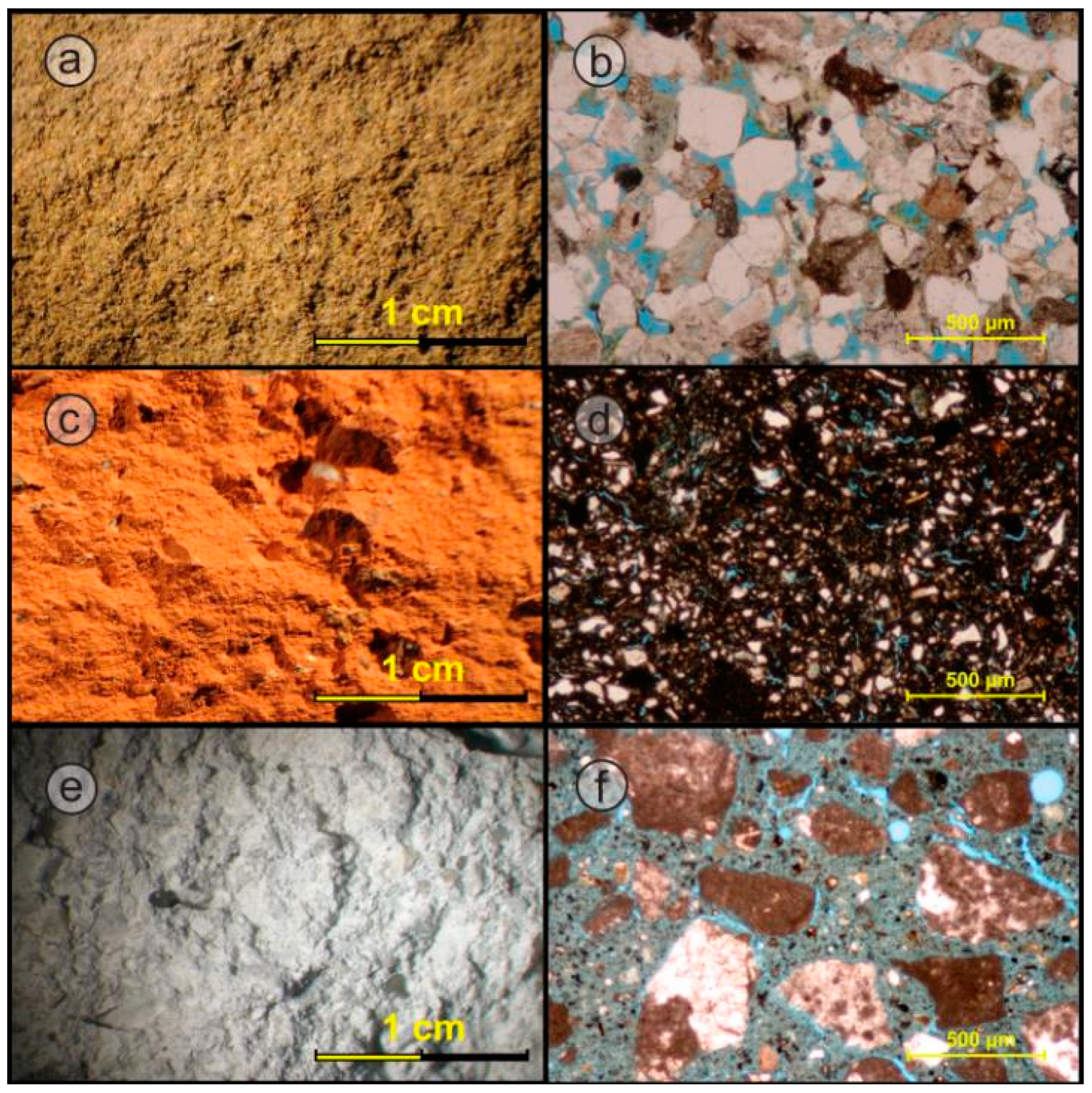
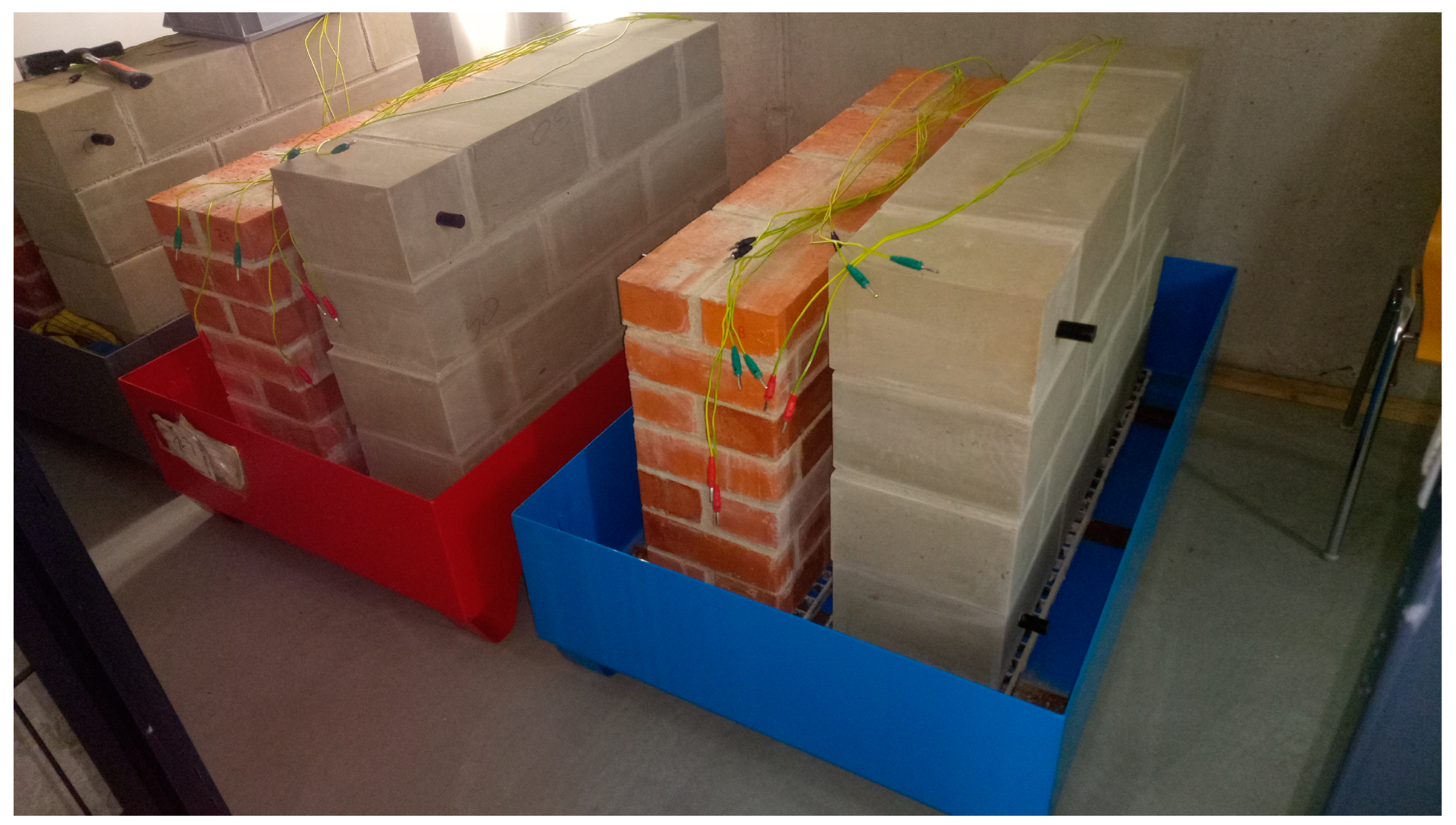
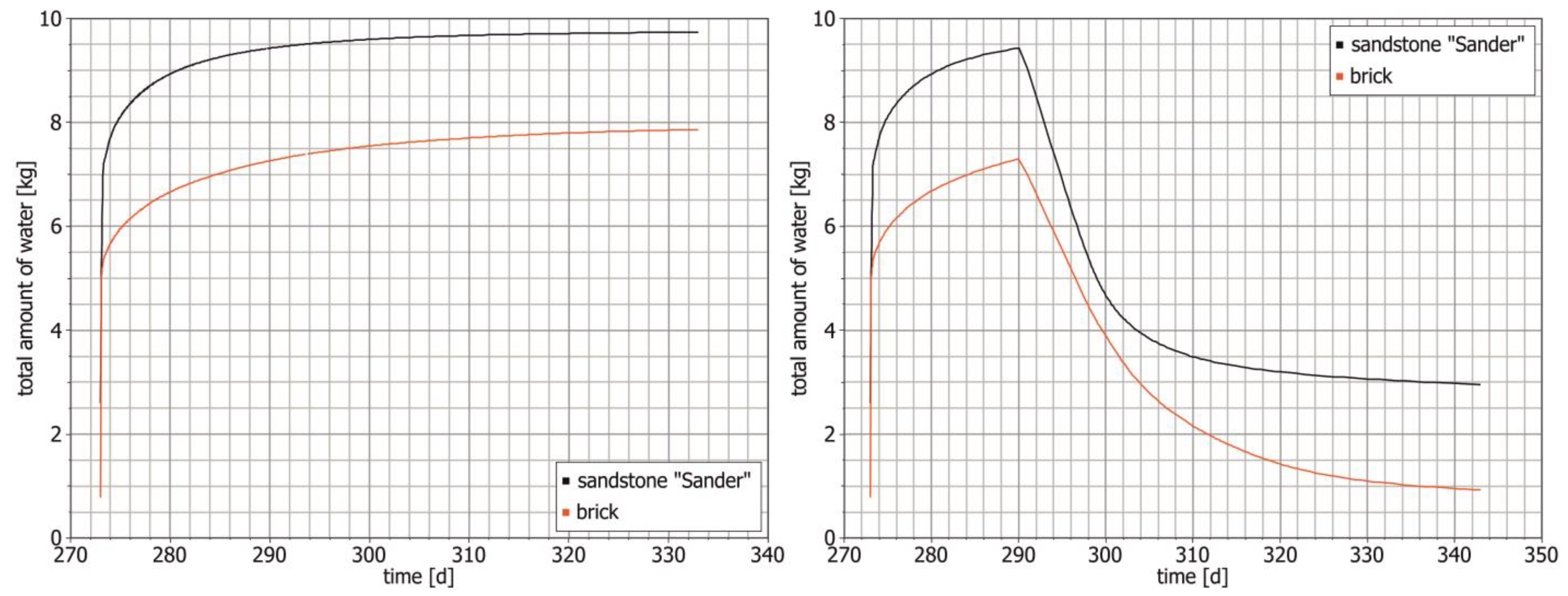
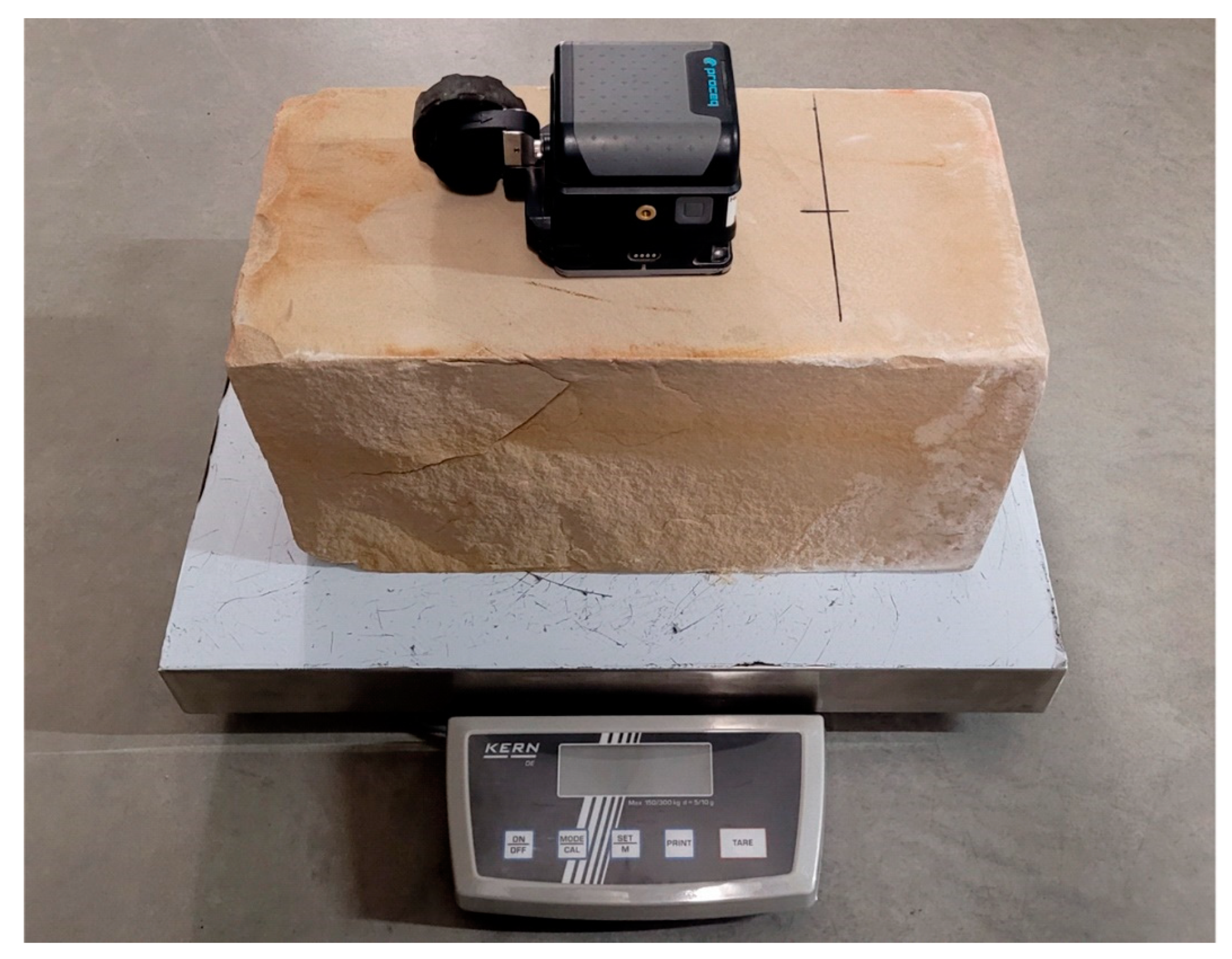
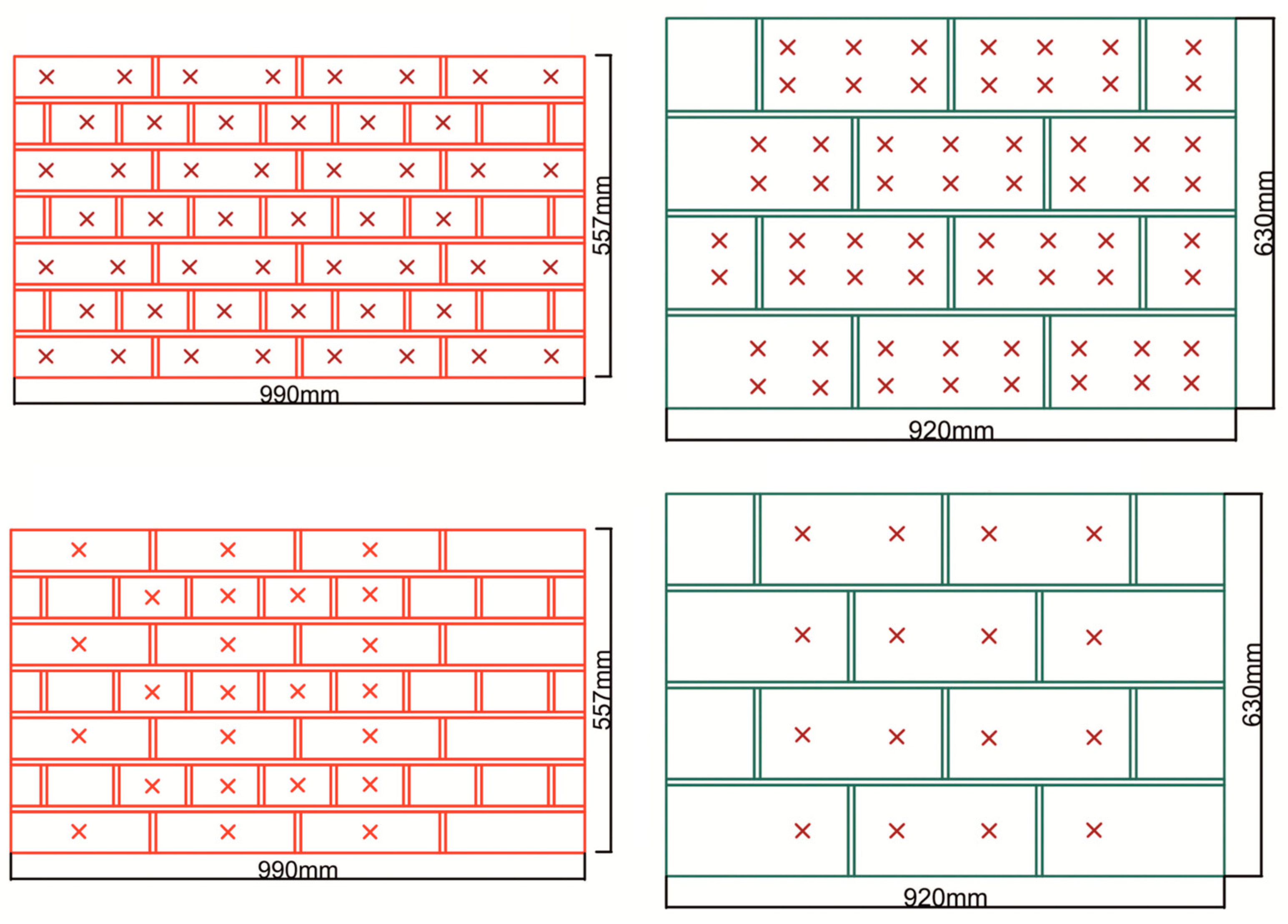
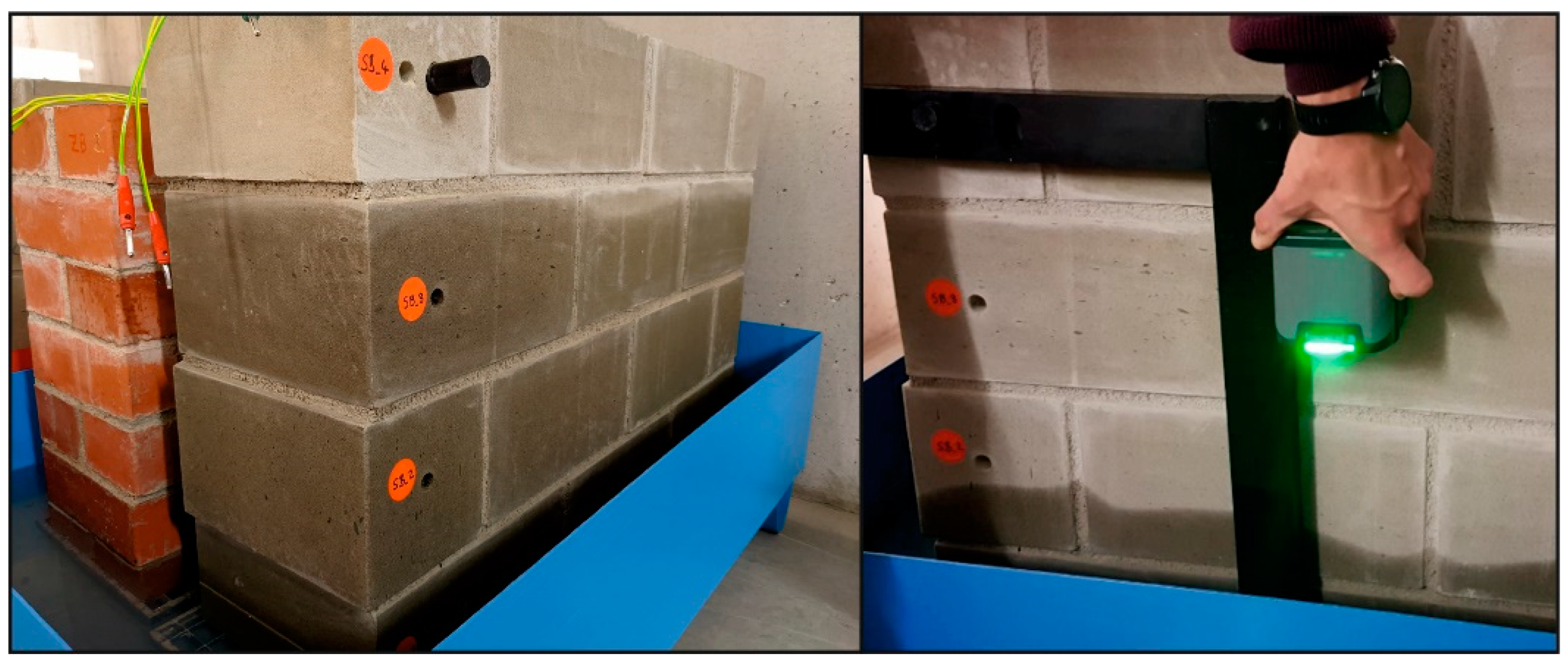
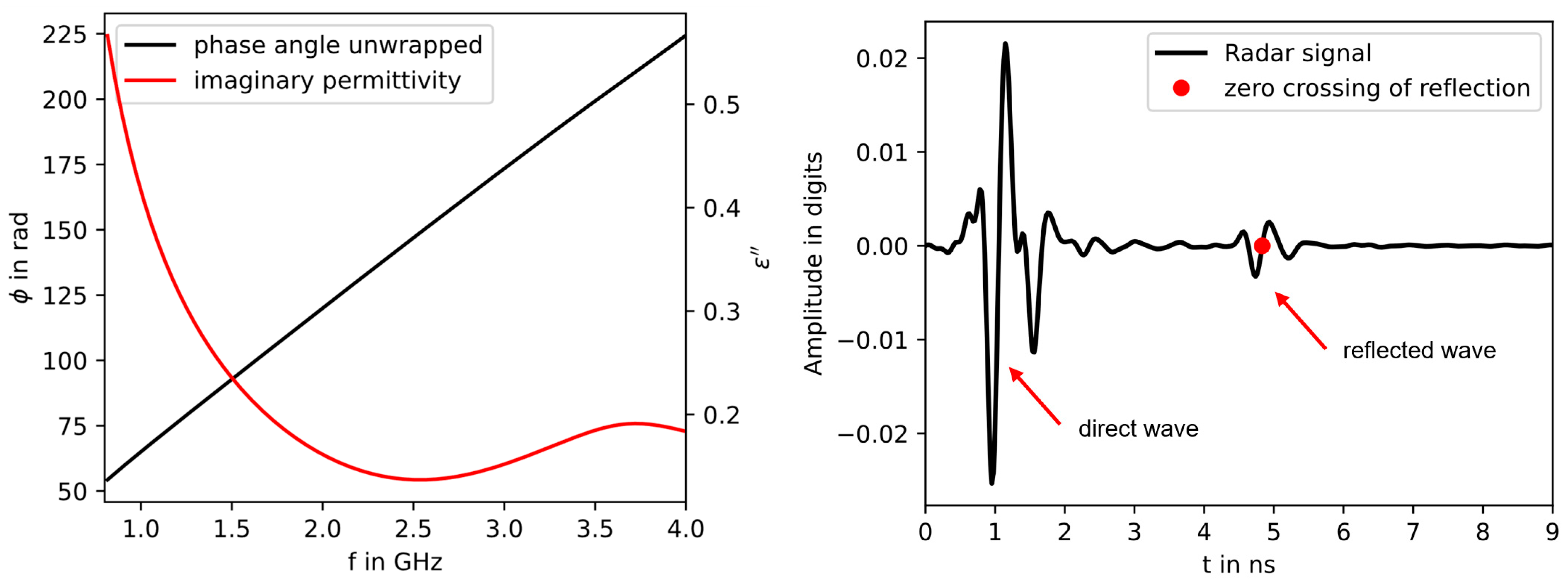
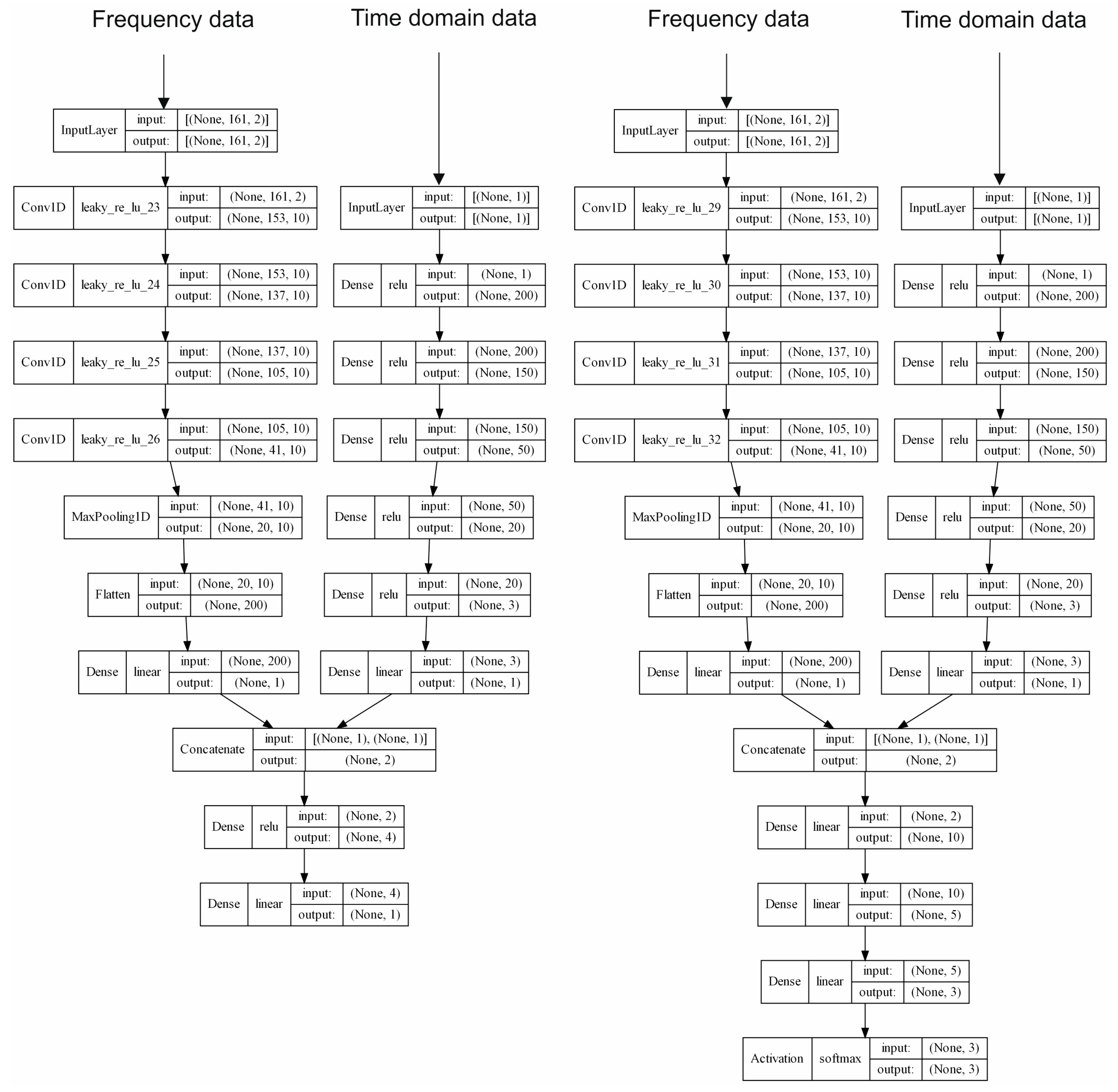
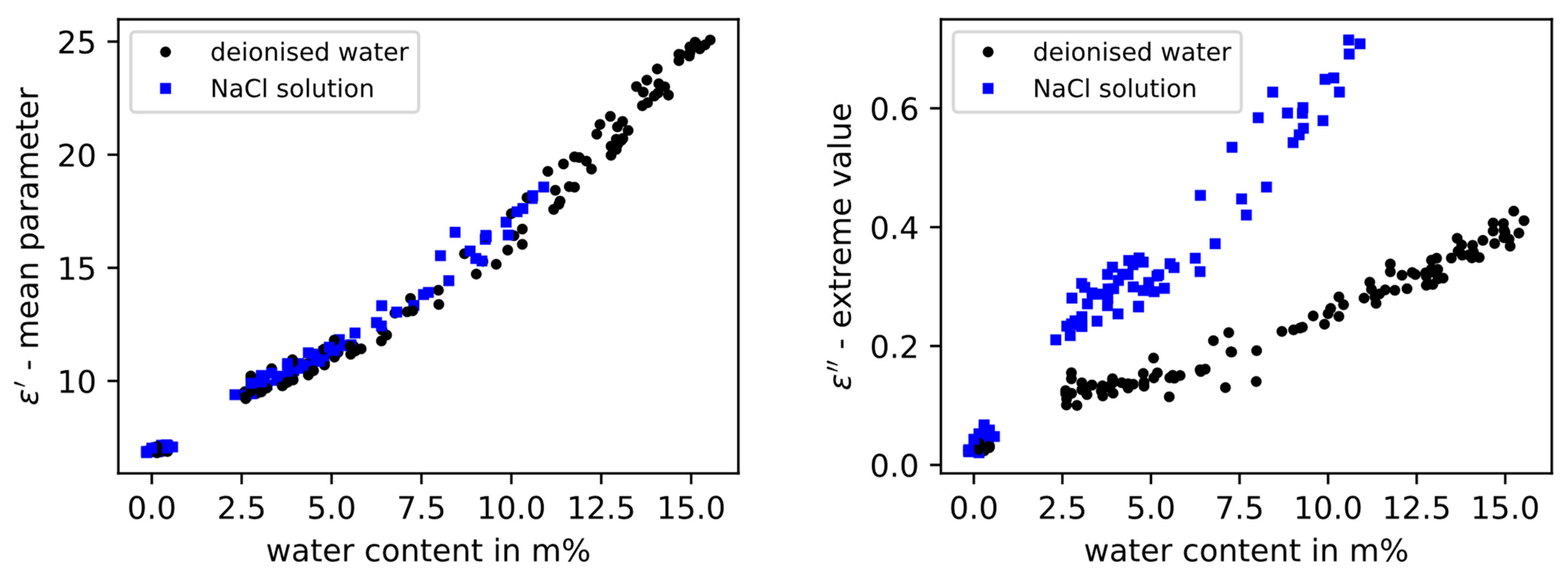
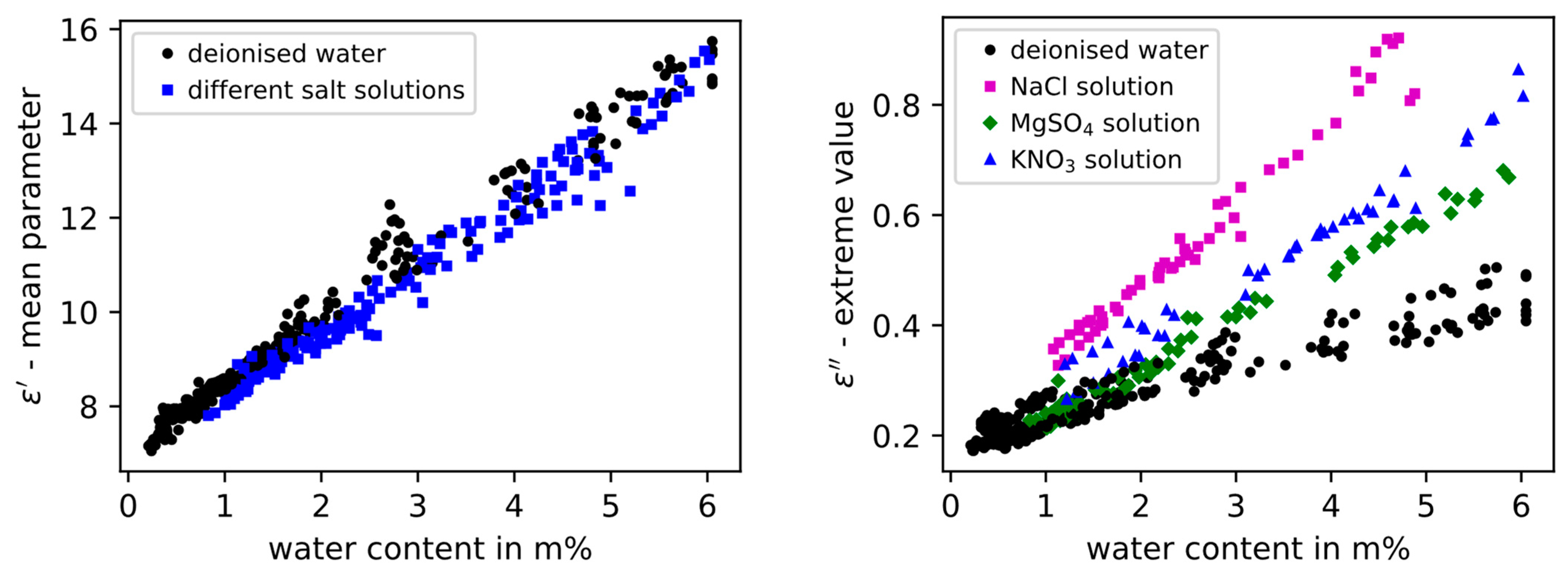
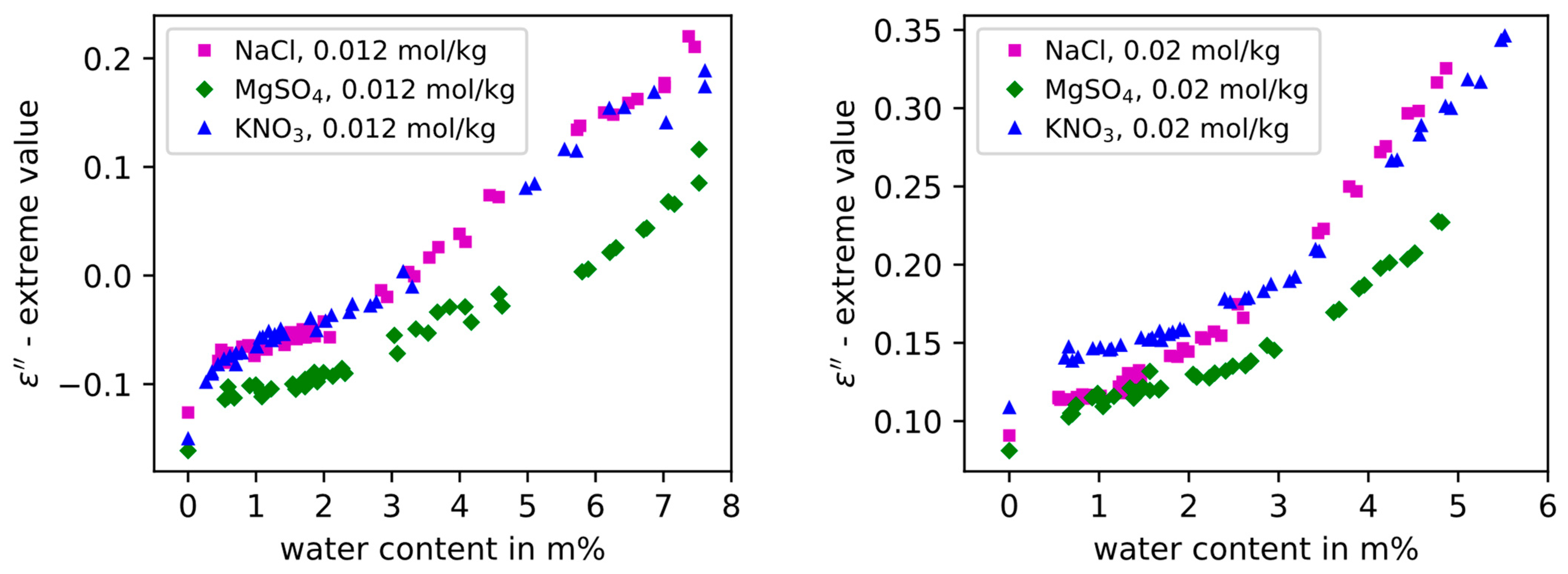
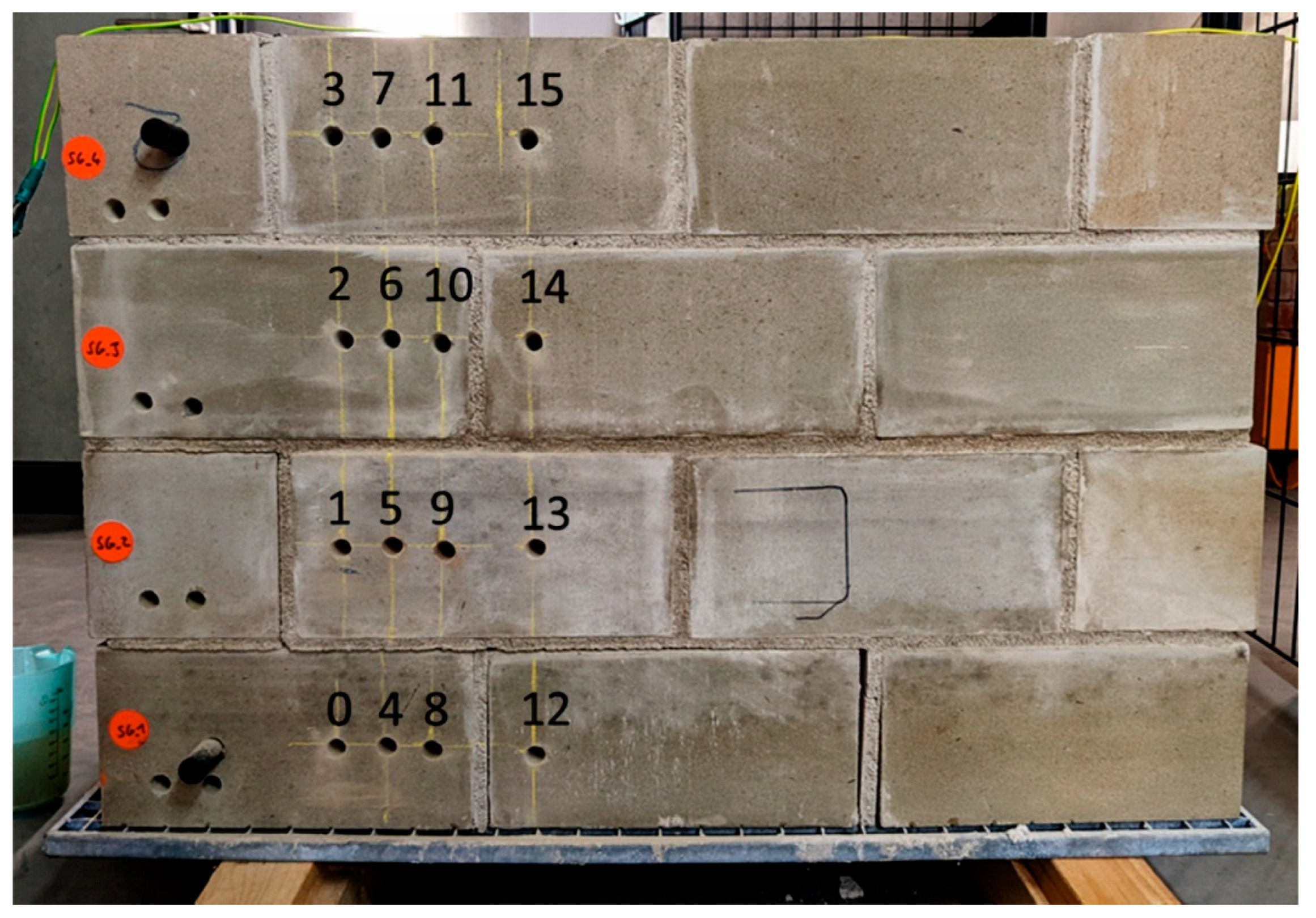
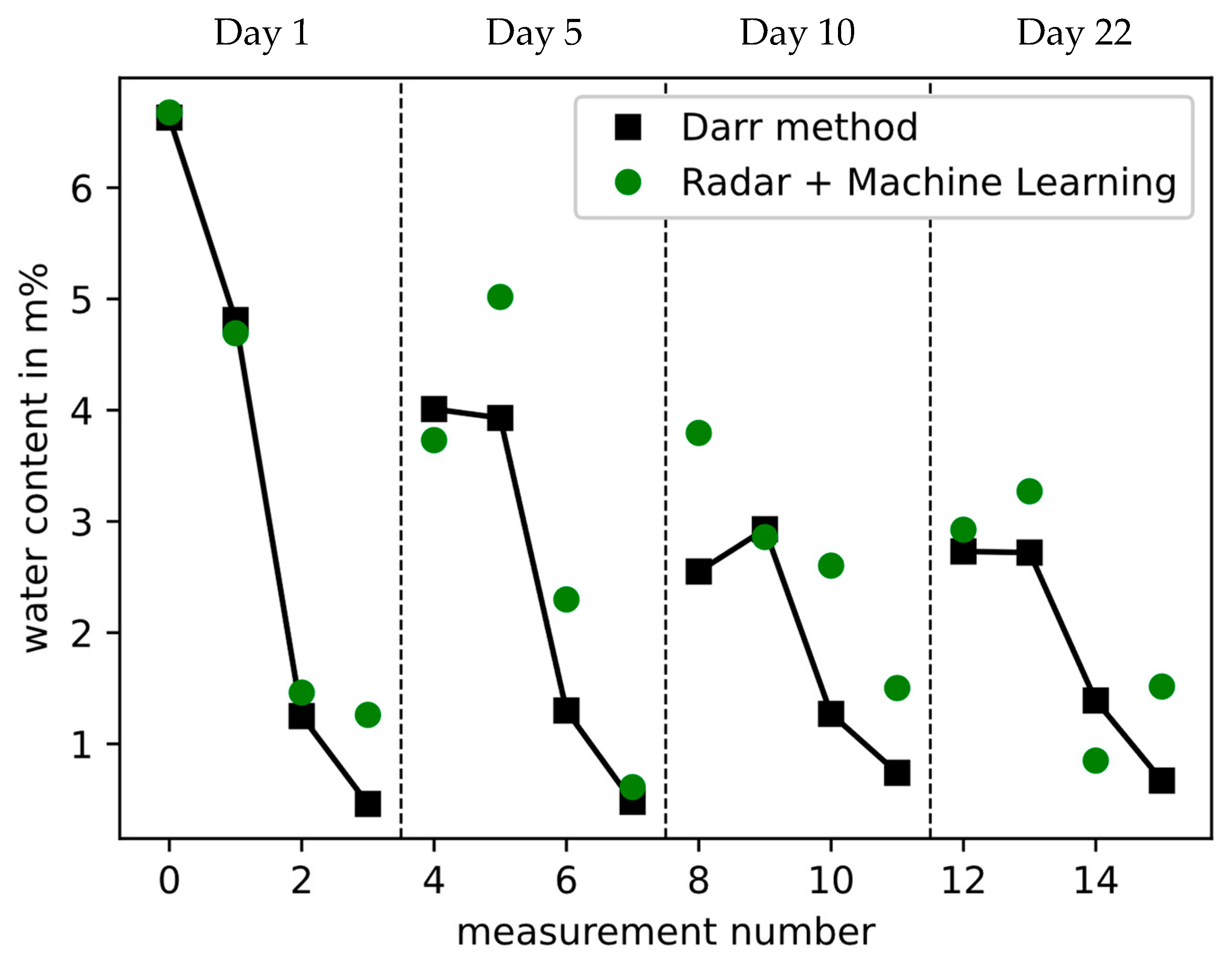



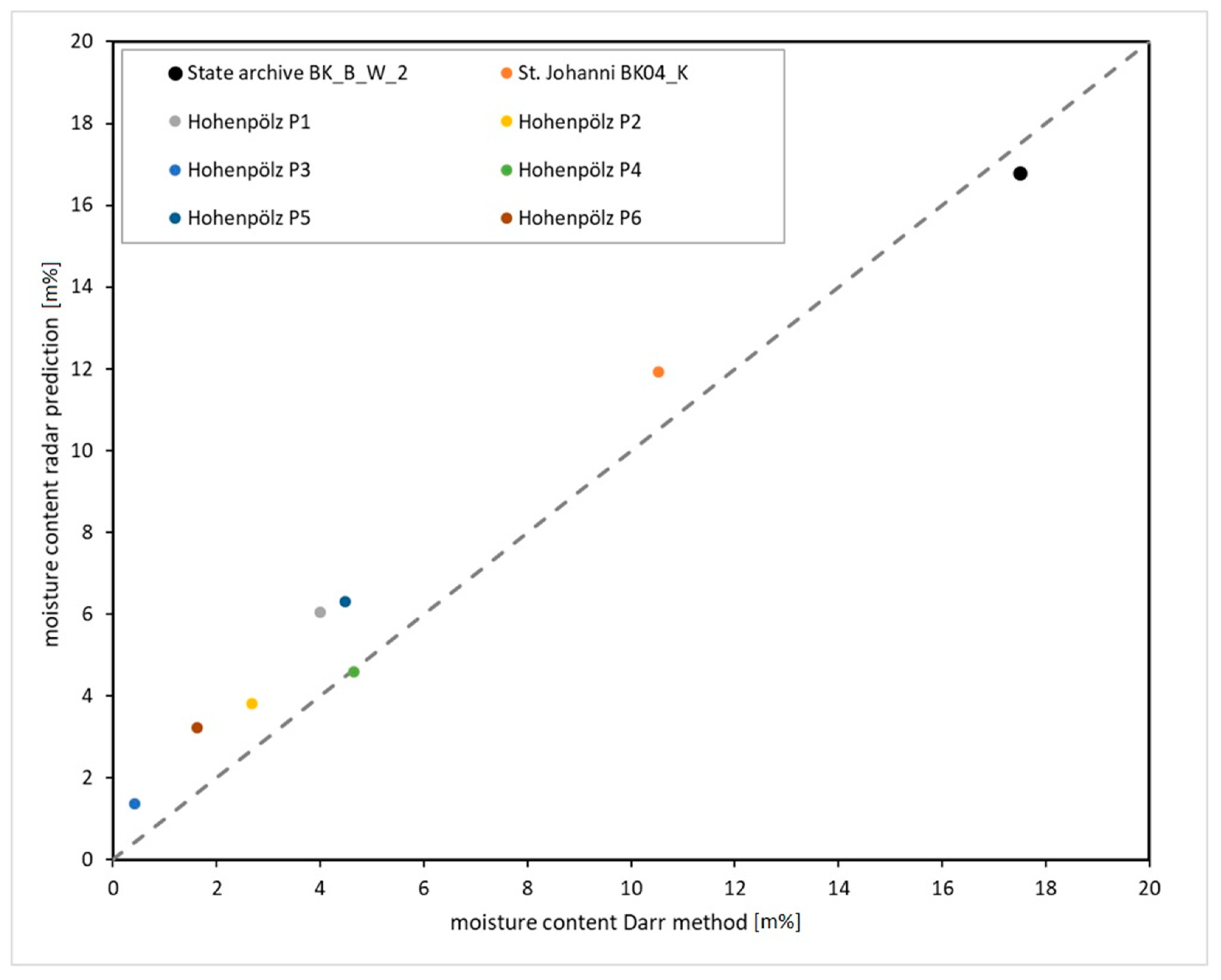
| Sample | Properties of the Material | |||||||
|---|---|---|---|---|---|---|---|---|
| Waa (Atmospheric) | Wav (Vacuum) | WAvol. | Poros. | Saturation Coefficient | pure-D. | raw-D. | A-Coefficient | |
| [m%] | [m%] | [Vol.%] | [Vol.%] | [g/cm³] | [g/cm³] | [kg/m2 × h0.5] | ||
| SST | 8.04 | 11.83 | 16.16 | 23.78 | 0.68 | 2.64 | 2.01 | 8.46 |
| SBM | 13.93 | 15.32 | 25.60 | 28.16 | 0.91 | 2.56 | 1.84 | 13.6 |
| TLM | 17.42 | 20.60 | 29.73 | 35.16 | 0.85 | 2.63 | 1.71 | 15.34 |
| Sample | Length | Material | Moisture Content Darr Method | WAa | Degree of Moisture Penetration | Moisture Content Radar Prediction | |
|---|---|---|---|---|---|---|---|
| From (cm) | To (cm) | (m%) | (m%) | (%) | (m%) | ||
| State archive, Nuremberg | |||||||
| BK_B_W_2/1 | 1 | 17 | brick | 17.50 | 16.82 | 100 | 16.8 |
| Primary school St. Johannis, Nuremberg | |||||||
| BK04_K | 2 | 10 | brick | 10.53 | 15.13 | 69.6 | 11.93 |
| Historical house, Hohenpoelz | |||||||
| P1 | 0 | 13 | brick | 3.99 | 17.56 | 22.7 | 6.04 |
| P2 | 0 | 13 | brick | 2.68 | 17.56 | 15.2 | 3.82 |
| P3 | 0- | 13 | brick | 0.41 | 17.56 | 2.3 | 1.37 |
| P4 | 0 | 15 | brick plastered | 4.64 | 17.56 | 26.4 | 4.6 |
| P5 | 0 | 15 | brick plastered | 4.48 | 17.56 | 25.5 | 6.32 |
| P6 | 0 | 15 | brick plastered | 1.62 | 17.56 | 9.2 | 3.22 |
Disclaimer/Publisher’s Note: The statements, opinions and data contained in all publications are solely those of the individual author(s) and contributor(s) and not of MDPI and/or the editor(s). MDPI and/or the editor(s) disclaim responsibility for any injury to people or property resulting from any ideas, methods, instructions or products referred to in the content. |
© 2023 by the authors. Licensee MDPI, Basel, Switzerland. This article is an open access article distributed under the terms and conditions of the Creative Commons Attribution (CC BY) license (https://creativecommons.org/licenses/by/4.0/).
Share and Cite
Frenzel, D.; Blaschke, O.; Franzen, C.; Brand, F.; Haas, F.; Troi, A.; Drese, K.S. Quantification of Moisture in Masonry via AI-Evaluated Broadband Radar Reflectometry. Heritage 2023, 6, 5030-5050. https://doi.org/10.3390/heritage6070266
Frenzel D, Blaschke O, Franzen C, Brand F, Haas F, Troi A, Drese KS. Quantification of Moisture in Masonry via AI-Evaluated Broadband Radar Reflectometry. Heritage. 2023; 6(7):5030-5050. https://doi.org/10.3390/heritage6070266
Chicago/Turabian StyleFrenzel, Daniel, Oliver Blaschke, Christoph Franzen, Felix Brand, Franziska Haas, Alexandra Troi, and Klaus Stefan Drese. 2023. "Quantification of Moisture in Masonry via AI-Evaluated Broadband Radar Reflectometry" Heritage 6, no. 7: 5030-5050. https://doi.org/10.3390/heritage6070266
APA StyleFrenzel, D., Blaschke, O., Franzen, C., Brand, F., Haas, F., Troi, A., & Drese, K. S. (2023). Quantification of Moisture in Masonry via AI-Evaluated Broadband Radar Reflectometry. Heritage, 6(7), 5030-5050. https://doi.org/10.3390/heritage6070266








